INAUSPICIOUS JAPANESE NEW YEARS
'Helpless': Japan earthquake shatters New Year calm
Shika (Japan) (AFP) – Waiting in the cold, hundreds of residents of the earthquake-hit Japanese town of Shika stood in a queue to get rations of a suddenly scarce, but vital, commodity: drinking water.
Issued on: 02/01/2024

Shika (Japan) (AFP) – Waiting in the cold, hundreds of residents of the earthquake-hit Japanese town of Shika stood in a queue to get rations of a suddenly scarce, but vital, commodity: drinking water.
Issued on: 02/01/2024

The earthquake left deep cracks in concrete and brought down entire wooden homes so only their tiled roofs lay on the ground
© Kazuhiro NOGI / AFP
The line snaked out the door and around the town hall building, past paving stones jutting out of the ground that were forced upwards by the powerful series of tremors on New Year's Day.
Taps ran dry in many homes as dozens of aftershocks rocked Shika and other towns in the central Ishikawa region following a 7.5-magnitude earthquake.
Among those waiting for their six allocated litres (1.6 gallons) of water on Tuesday was Tsugumasa Mihara, who told AFP that the huge jolt was unlike anything he had experienced before.
The 73-year-old had just given his grandchildren a traditional New Year's Day gift of pocket money and was taking a nap when he was rattled awake by the quake.

The line snaked out the door and around the town hall building, past paving stones jutting out of the ground that were forced upwards by the powerful series of tremors on New Year's Day.
Taps ran dry in many homes as dozens of aftershocks rocked Shika and other towns in the central Ishikawa region following a 7.5-magnitude earthquake.
Among those waiting for their six allocated litres (1.6 gallons) of water on Tuesday was Tsugumasa Mihara, who told AFP that the huge jolt was unlike anything he had experienced before.
The 73-year-old had just given his grandchildren a traditional New Year's Day gift of pocket money and was taking a nap when he was rattled awake by the quake.

Taps ran dry in many homes as dozens of aftershocks rocked Shika and other towns in the central Ishikawa region after the initial earthquake
© Kazuhiro NOGI / AFP
"I was just helpless," he said. "All I could do at the time was pray that it would end soon."
The earthquake left broken dishes scattered in his kitchen, but no one was hurt in Mihara's family and his home still has electricity.
Now, "the problem is water".
Yuko, a 58-year-old resident, was also waiting for water, handed out in small plastic packets by a masked official in a blue jacket.
"I was on the second floor watching TV when the quake struck," she said, adding that she had to hold on to the screen to stop it from toppling over.
"I feared for my life of course, but I couldn't just run away, because I live with my family."
'Feared for my life'
The spate of earthquakes toppled large buildings, triggered a tsunami of more than a metre and saw a huge fire sparked in the city of Wajima, razing part of a market area.
By Tuesday, at least 48 people had been confirmed dead in the disaster, which left deep cracks in concrete and brought down entire wooden homes so only their tiled roofs lay on the ground.

"I was just helpless," he said. "All I could do at the time was pray that it would end soon."
The earthquake left broken dishes scattered in his kitchen, but no one was hurt in Mihara's family and his home still has electricity.
Now, "the problem is water".
Yuko, a 58-year-old resident, was also waiting for water, handed out in small plastic packets by a masked official in a blue jacket.
"I was on the second floor watching TV when the quake struck," she said, adding that she had to hold on to the screen to stop it from toppling over.
"I feared for my life of course, but I couldn't just run away, because I live with my family."
'Feared for my life'
The spate of earthquakes toppled large buildings, triggered a tsunami of more than a metre and saw a huge fire sparked in the city of Wajima, razing part of a market area.
By Tuesday, at least 48 people had been confirmed dead in the disaster, which left deep cracks in concrete and brought down entire wooden homes so only their tiled roofs lay on the ground.

The spate of earthquakes toppled large buildings, triggered a tsunami of more than a metre and saw a huge fire sparked in the city of Wajima, razing part of a market area
© Kazuhiro NOGI / AFP
After the main shockwave on Monday -- a public holiday in Japan, when loved ones gather to ring in the New Year -- people in the worst-hit areas were urged to evacuate as authorities warned of the possibility of large tsunami waves.
There was an eerie quiet in a no-go area for vehicles near Shika, where AFP journalists saw an abandoned car stuck in a crack in the road.
Residents queued outside supermarkets to stock up on supplies, but some convenience stores were closed because there had been no product deliveries.
A sign at one store told customers: "We're closed today. We're evacuating."
Relief efforts were under way, with construction workers trying to mend road cracks with heavy machinery as rescue, army and police vehicles rushed to the scene.

After the main shockwave on Monday -- a public holiday in Japan, when loved ones gather to ring in the New Year -- people in the worst-hit areas were urged to evacuate as authorities warned of the possibility of large tsunami waves.
There was an eerie quiet in a no-go area for vehicles near Shika, where AFP journalists saw an abandoned car stuck in a crack in the road.
Residents queued outside supermarkets to stock up on supplies, but some convenience stores were closed because there had been no product deliveries.
A sign at one store told customers: "We're closed today. We're evacuating."
Relief efforts were under way, with construction workers trying to mend road cracks with heavy machinery as rescue, army and police vehicles rushed to the scene.

The line for water snaked out the door and around the town hall building, past paving stones jutting out of the ground that were forced upwards by the tremors
© Kazuhiro NOGI / AFP
A family, including grandparents and children, stood outside a tilted traditional wooden home in Wajima.
The children's mother Akiko, 46, described the earthquake as "long and violent" and said they could not return to their home because the roads were blocked.
"Even if we do manage to return home, I don't think we can go back to normal any time soon" because of the scarcity of basic necessities such as water, she said.
The family and their neighbours go to a nearby evacuation centre to relieve themselves, using plastic bags placed in toilets, with the bags changed out manually by residents when full.
"I'm worried about potential infections," Akiko said.
The start of 2024 would, she said, "be etched into my memory forever".
"I was reminded of how precious leading a normal life is," she added.
"We've experienced the absolute worst, so... now I will just move forwards, trying to get our life back".
© 2024 AFP
A family, including grandparents and children, stood outside a tilted traditional wooden home in Wajima.
The children's mother Akiko, 46, described the earthquake as "long and violent" and said they could not return to their home because the roads were blocked.
"Even if we do manage to return home, I don't think we can go back to normal any time soon" because of the scarcity of basic necessities such as water, she said.
The family and their neighbours go to a nearby evacuation centre to relieve themselves, using plastic bags placed in toilets, with the bags changed out manually by residents when full.
"I'm worried about potential infections," Akiko said.
The start of 2024 would, she said, "be etched into my memory forever".
"I was reminded of how precious leading a normal life is," she added.
"We've experienced the absolute worst, so... now I will just move forwards, trying to get our life back".
© 2024 AFP
48 Dead, Thousands Evacuated As 155 Earthquakes, Including One Of 7.6 Magnitude Hit Japan |
From toppled buildings, and sunken boats at a port to power outages in the middle of freezing overnight temperatures - the series of quakes in Japan has left a massive trail of destruction, as per several footages online.

Earthquakes led to cracks in the ground in Wajima, Ishikawa prefecture, Japan AP
UPDATED: 02 JAN 2024
In a series of deadly earthquakes since Monday, Japan has been jolted by 155 quakes including a 7.6-magnitude and another over 6, the Japan Meteorological Office said. According to the officials, at least forty-eight people died in a major earthquake that struck central Japan on New Year's Day.
According to the US Geological Survey (USGS), the quake which struck Ishikawa prefecture on the main island of Honshu had a magnitude of 7.5 while the Japanese authorities claimed it to be 7.6 on the Richter Scale and said it was one of more than 90 quakes that had rocked the region as of 1:00 am Tuesday (1600 GMT Monday).
On average, most of the quakes had a magnitude greater than 3 and while the strength has gradually moderated, six strong jolts were still felt early Tuesday, the JMA said.
From toppled buildings, sunken boats at a port to power outages in the middle of freezing overnight temperatures - the series of quakes have left a massive trail of destruction, as per several footages online.
In a series of deadly earthquakes since Monday, Japan has been jolted by 155 quakes including a 7.6-magnitude and another over 6, the Japan Meteorological Office said. According to the officials, at least forty-eight people died in a major earthquake that struck central Japan on New Year's Day.
According to the US Geological Survey (USGS), the quake which struck Ishikawa prefecture on the main island of Honshu had a magnitude of 7.5 while the Japanese authorities claimed it to be 7.6 on the Richter Scale and said it was one of more than 90 quakes that had rocked the region as of 1:00 am Tuesday (1600 GMT Monday).
On average, most of the quakes had a magnitude greater than 3 and while the strength has gradually moderated, six strong jolts were still felt early Tuesday, the JMA said.
From toppled buildings, sunken boats at a port to power outages in the middle of freezing overnight temperatures - the series of quakes have left a massive trail of destruction, as per several footages online.
155 earthquakes devastate Japan: Status quo
The quake reportedly triggered tsunami waves over a metre high which damaged several homes and caused the breakout of a major fire which led to the issuing of the highest-level tsunami alert. However, later the alert was dropped but the authorities told residents of coastal areas not to return to their homes as deadly waves could still come.
Around 32,700 households in the region remained without power on Tuesday, the local energy provider said.
Waves at least 1.2 metres (four feet) high hit the port of Wajima on Monday, and a series of smaller tsunamis were reported elsewhere, but warnings of much larger waves proved unfounded.
Bullet trains reach station after 11 hours of wait
Owing to the strong tremors and aftershocks, four Hokuriku Shinkansen bullet trains finally managed to reach the tations after being stranded for about 11 hours.It has been reported that the train service was suspended after the quake struck at 4:10 p.m. on Monday, stranding about 1,400 passengers.
The stranded bullet trains reached the stations by 4 am on Tuesday.
According to the railway operator, despite all the adversities, the trains maintained power and the passengers were also provided with food.
What do the authorities say?
According to the fire and disaster management agency, in light of the catastrophic event, tens of thousands of people had been evacuated, cited by Kyodo. About 1,000 people were staying at a military base.
"I instructed (emergency workers) to reach the area as soon as possible by using whatever means available," Prime Minister Fumio Kishida said late Monday after a disaster response meeting.
"It is very cold now. I issued an instruction to deliver necessary supplies like water, food, blankets, heating oil, gasoline, fuel oil, by using planes or ships," Kishida told reporters.
At least 30 people dead in Japan earthquake, as rescuers 'battle against time' to free survivors from rubble
2 January 2024,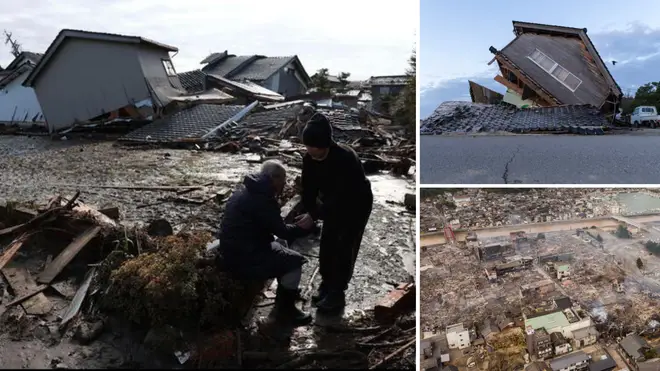
2 January 2024,

At least 30 people have been killed in earthquakes in Japan. Picture: Alamy/Getty
By Kit Heren@yung_chuvak
At least 30 people have died after an earthquake struck Japan on Monday, as rescuers "battle against time" to free people trapped under the rubble of collapsed buildings
Around 50 earthquakes struck the north central area of Japan, triggering tsunami waves, destroying buildings and starting fires on the island of Honshu.
Seven people are thought to be seriously injured in the earthquakes, alongside the 30 confirmed to have died by Tuesday morning UK time.
The largest earthquake reached 7.6 on the Richter scale, and more tremors are expected in the days to come.
The worst-hit area is the Ishikawa prefecture on the western side of Honshu island.
Read more: 'Survivors buried under rubble' as 7.6 magnitude earthquake triggers tsunami waves and destroys houses in Japan

By Kit Heren@yung_chuvak
At least 30 people have died after an earthquake struck Japan on Monday, as rescuers "battle against time" to free people trapped under the rubble of collapsed buildings
Around 50 earthquakes struck the north central area of Japan, triggering tsunami waves, destroying buildings and starting fires on the island of Honshu.
Seven people are thought to be seriously injured in the earthquakes, alongside the 30 confirmed to have died by Tuesday morning UK time.
The largest earthquake reached 7.6 on the Richter scale, and more tremors are expected in the days to come.
The worst-hit area is the Ishikawa prefecture on the western side of Honshu island.
Read more: 'Survivors buried under rubble' as 7.6 magnitude earthquake triggers tsunami waves and destroys houses in Japan

A car passes a collapsed wooden house in Shika Town, Ishikawa prefecture on January 2, 2024. 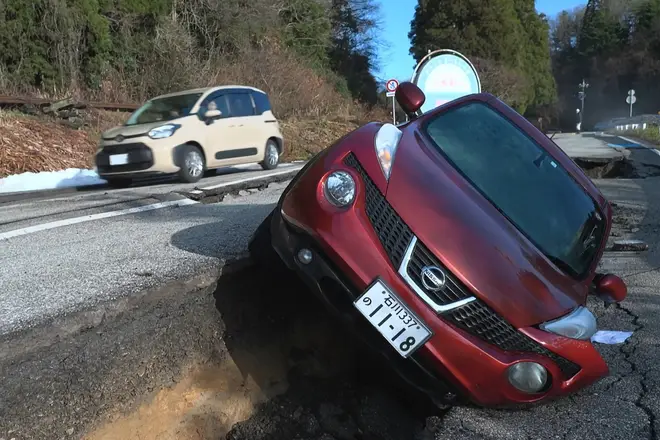
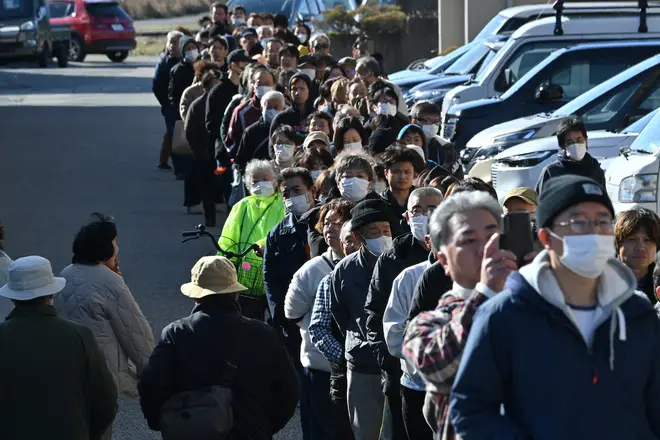
Around 1,000 emergency services staff have been dispatched to help free people from the rubble.
But their efforts have been hampered by damaged and blocked roads. One of the local airports has been forced to close after a crack appeared in its runway.
Japanese Prime Minister Fumio Kishida told broadcasters: "The search and rescue of those impacted by the quake is a battle against time.
"We must rescue them as quickly as possible, especially those who are trapped under collapsed structures."
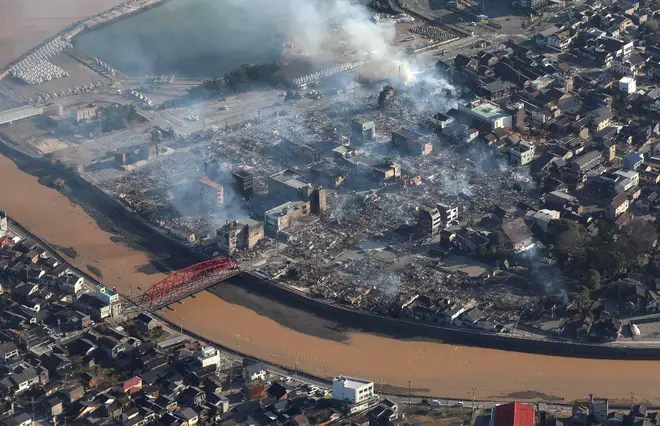

A damaged car left on the side of the road in Wajima, Ishikawa prefecture.

People queue for water at a distribution point after the earthquake
Around 1,000 emergency services staff have been dispatched to help free people from the rubble.
But their efforts have been hampered by damaged and blocked roads. One of the local airports has been forced to close after a crack appeared in its runway.
Japanese Prime Minister Fumio Kishida told broadcasters: "The search and rescue of those impacted by the quake is a battle against time.
"We must rescue them as quickly as possible, especially those who are trapped under collapsed structures."

Smoke rising following a large fire in Wajima, Ishikawa prefecture on January 2, 2024 after the earthquake. 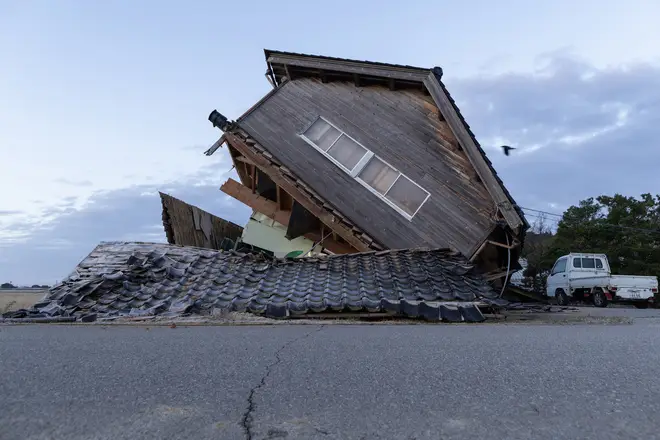
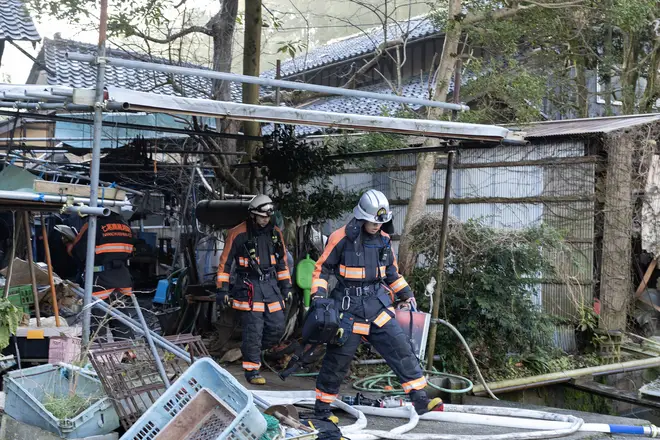

A house damaged by an earthquake is seen on January 02, 2024 in Nanao, Japan.

Firefighters investigate a partly burned and collapsed house on January 02, 2024 in Nanao, Japan.
Picture: Getty
In the aftermath of the earthquakes people were urged to flee to high ground or to get to the top of buildings as fast as possible.
Warnings of waves as tall as five metres (16ft) were made for Noto, Ishikawa Prefecture, while NHK, Japan's national broadcaster, said tsunami waves bigger than one metre hit the north coast of central Japan.
Later, that warning was downgraded as three metre tall (9.8ft) waves were predicted.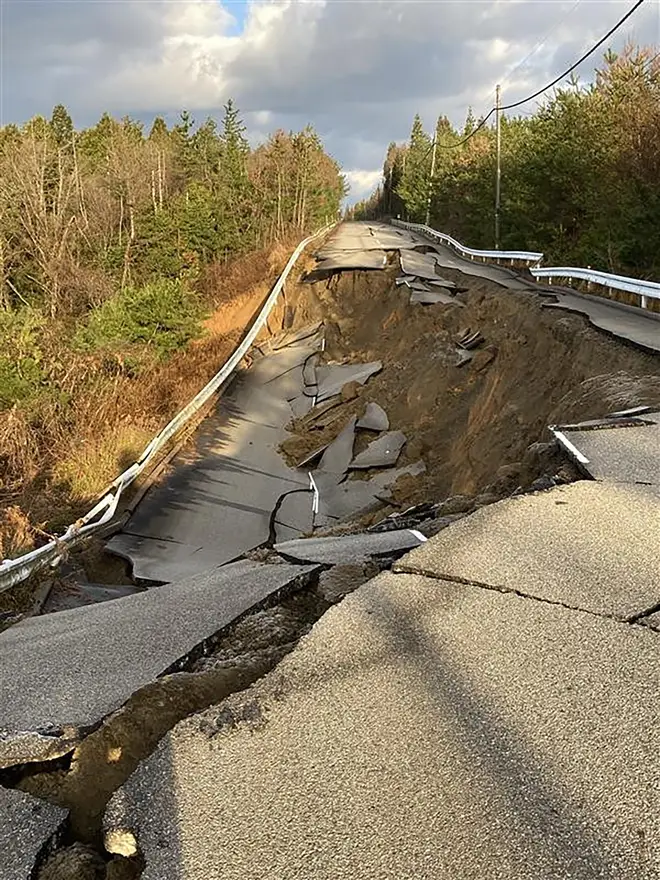
In the aftermath of the earthquakes people were urged to flee to high ground or to get to the top of buildings as fast as possible.
Warnings of waves as tall as five metres (16ft) were made for Noto, Ishikawa Prefecture, while NHK, Japan's national broadcaster, said tsunami waves bigger than one metre hit the north coast of central Japan.
Later, that warning was downgraded as three metre tall (9.8ft) waves were predicted.

A collapsed road near the city of Shika, Ishikawa prefecture on January 2, 2024.
All Pictures: Getty
Reacting to the disaster, Rishi Sunak said: "My thoughts are with all those affected by the earthquakes in Japan which have caused such terrible damage.
"Prime minister Fumio Kishida is a great friend of the UK and we stand ready to support Japan and are monitoring developments closely.
"British nationals in the affected areas should follow the advice of the Japanese authorities."
The comments came shortly after US President Joe Biden said his administration was in touch with officials in Tokyo and "ready to provide any necessary assistance for the Japanese people".
Japan is extremely earthquake-prone, but a tsunami warning of the magnitude of Monday's had not been issued since a major quake and tsunami caused meltdowns at a nuclear plant in March 2011.
Reacting to the disaster, Rishi Sunak said: "My thoughts are with all those affected by the earthquakes in Japan which have caused such terrible damage.
"Prime minister Fumio Kishida is a great friend of the UK and we stand ready to support Japan and are monitoring developments closely.
"British nationals in the affected areas should follow the advice of the Japanese authorities."
The comments came shortly after US President Joe Biden said his administration was in touch with officials in Tokyo and "ready to provide any necessary assistance for the Japanese people".
Japan is extremely earthquake-prone, but a tsunami warning of the magnitude of Monday's had not been issued since a major quake and tsunami caused meltdowns at a nuclear plant in March 2011.
Natural Calamities That Wrecked Japan Over The Last Three Decades
Japan currently tackling the effect of a 7.8 magnitude earthquake has been perturbed by fatal natural disasters for centuries owing to numerous geographical factors. Outlook looks at the deadliest disasters that shook Japan over the last thirty years.

Agnideb Bandyopadhyay
UPDATED: 02 JAN 2024
Japan has always been a hotbed for deadly natural disasters and people continue to live in the reality of it. The island nation which finds itself lying across three tectonic plates, including the Pacific Plate under the Pacific Ocean and the Philippine Sea Plate, also falls on the Cirucm-Pacific belt or the 'Ring of Fire' which is a path along the Pacific Ocean dotted with active volcanoes. The tectonic shifts have led to earthquakes of massive seismic intensity and numerous tsunamis causing immense destruction. Presently grappling with the havoc that the 7.8 magnitude earthquake wreaked, on New Year's Day, which has already resulted in loss of around fifty lives, Japan continues to gasp for breath.
Outlook looks at major natural disasters that scourged Japan over the last three decades.
2011 Tohoku Earthquake and Tsunami
March 11, 2011,
1995 The Great Hashin Earthquake
Clocking a maximum intensity of 7.0, the earthquake took place in the southern part of the Hyogo Prefecture, including Hanshin. Kobe and Osaka, the cities closest to the epicentre experienced powerful tremors leading to immense death and destruction. Around 6434 people died as a result, and it was the deadliest earthquake to hit Japan since the 1923 Great Kanto Earthquake.
2018 Japan Floods
In June through mid-July 2018, Japan experienced successive heavy downpours resulting in devastating floods and mudflows. The mudslides and the landslides led to the death of 225 people across 15 prefectures, with it being the deadliest freshwater related disaster in Japan since the 1982 Nagasaki floods.
2004 Chuetsu Earthquake
The earthquake occurred on October 23, 2004, in the Nigara prefecture in Japan, which is in the Horishu region of Honshu. With a recorded magnitude of 6.6, the tremors were felt in major areas across half of the island of Honshu and resulted in the loss of 68 people with around 4805 people missing.
2014 Mount Ontake Eruption
The island of Honshu witnessed a fatal volcanic eruption of Mount Ontake on September 27, 2014. It was the deadliest volcanic eruption since Torishima in 1902. A popular tourist attraction for hikers and a relatively safe one as well, several hundred people were on its slopes during the eruption. The final numbers reported the death of 63 people.
Japan currently tackling the effect of a 7.8 magnitude earthquake has been perturbed by fatal natural disasters for centuries owing to numerous geographical factors. Outlook looks at the deadliest disasters that shook Japan over the last thirty years.

Damaged roads and debris following the Chutes Earthquake in 2004 The Asahi Shimbun via Getty Images
Agnideb Bandyopadhyay
UPDATED: 02 JAN 2024
Japan has always been a hotbed for deadly natural disasters and people continue to live in the reality of it. The island nation which finds itself lying across three tectonic plates, including the Pacific Plate under the Pacific Ocean and the Philippine Sea Plate, also falls on the Cirucm-Pacific belt or the 'Ring of Fire' which is a path along the Pacific Ocean dotted with active volcanoes. The tectonic shifts have led to earthquakes of massive seismic intensity and numerous tsunamis causing immense destruction. Presently grappling with the havoc that the 7.8 magnitude earthquake wreaked, on New Year's Day, which has already resulted in loss of around fifty lives, Japan continues to gasp for breath.
Outlook looks at major natural disasters that scourged Japan over the last three decades.
2011 Tohoku Earthquake and Tsunami
March 11, 2011,
witnessed Japan's worst earthquake and tsunami at a recorded magnitude of 9.1. Occurring in the east of the Oshika Peninsula of the Tōhoku region, it lasted for approximately six minutes. The tsunami which happened as a result, saw waves as high as 40m in Miyako. The recorded number of deaths according to the official figures released in 2021 was 19,759 with around 6242 injured. The earthquake also triggered the Fukushima Daiichi nuclear disaster which involved the meltdowns of three of its reactors, and the discharge of radioactive water in Fukushima and other areas.
1995 The Great Hashin Earthquake
Clocking a maximum intensity of 7.0, the earthquake took place in the southern part of the Hyogo Prefecture, including Hanshin. Kobe and Osaka, the cities closest to the epicentre experienced powerful tremors leading to immense death and destruction. Around 6434 people died as a result, and it was the deadliest earthquake to hit Japan since the 1923 Great Kanto Earthquake.
2018 Japan Floods
In June through mid-July 2018, Japan experienced successive heavy downpours resulting in devastating floods and mudflows. The mudslides and the landslides led to the death of 225 people across 15 prefectures, with it being the deadliest freshwater related disaster in Japan since the 1982 Nagasaki floods.
2004 Chuetsu Earthquake
The earthquake occurred on October 23, 2004, in the Nigara prefecture in Japan, which is in the Horishu region of Honshu. With a recorded magnitude of 6.6, the tremors were felt in major areas across half of the island of Honshu and resulted in the loss of 68 people with around 4805 people missing.
2014 Mount Ontake Eruption
The island of Honshu witnessed a fatal volcanic eruption of Mount Ontake on September 27, 2014. It was the deadliest volcanic eruption since Torishima in 1902. A popular tourist attraction for hikers and a relatively safe one as well, several hundred people were on its slopes during the eruption. The final numbers reported the death of 63 people.
Five dead in Japan plane collision at Tokyo airport
Tokyo (AFP) – Five people aboard a Japan coast guard aircraft died Tuesday when it hit a Japan Airlines passenger plane on the ground in a fiery collision at Tokyo's Haneda airport.
Issued on: 02/01/2024 -

A Japan Airlines plane was in flames on the runway of Tokyo's Haneda Airport on Tuesday after apparently colliding with a coast guard aircraft
© STR / JIJI PRESS/AFP
All 379 passengers and crew on board the passenger plane which burst into flames were safely evacuated, Japanese transport minister Tetsuo Saito told reporters.
But five of the six crew members from the smaller plane -- bound for central Japan after Monday's huge earthquake -- died, Saito said.
The captain escaped and survived but was injured, he said, cautioning that "we're not at the stage to explain the cause" of the accident.
Television and unverified footage shared on social media showed the Japan Airlines (JAL) airliner moving along the runway before a large eruption of orange flames and black smoke burst from beneath and behind it.
Video posted to social media platform X showed people sliding down an inflatable emergency slide from the side of the passenger plane while flames shot out from the rear of the aircraft.
All 367 passengers plus 12 crew onboard were swiftly taken off the plane before dozens of fire engines with flashing blue lights sprayed the fuselage.
They however failed to put out the flames coming out of windows near the wings and the blaze soon engulfed the entire aircraft.
The plane, reportedly an Airbus 350, had arrived from New Chitose Airport serving Sapporo on the northern island of Hokkaido. Those on board included eight children.
"Smoke began to fill the plane, and I thought, 'this could be really bad'", an adult male passenger told reporters at the airport.
"An announcement said doors in the back and middle could not be opened. So everyone disembarked from the front," he said.
A female passenger said it had been dark on board as the fire intensified after landing.
"It was getting hot inside the plane, and I thought, to be honest, I would not survive," she said in comments shown on broadcaster NHK.
'Sense of mission'
The coast guard plane had been preparing to fly to Ishikawa prefecture to deliver supplies after the devastating New Year's Day earthquake which killed at least 48 people.
Prime Minister Fumio Kishida praised the deceased crew members on their way to help the victims of the quake.
"These were employees who had a high sense of mission and responsibility for the affected areas. It's very regrettable," he told reporters.
"I express my respect and gratitude to their sense of mission," Kishida said.
JAL said the passenger plane either collided with the other aircraft on a runway or a taxiway after it touched down, Kyodo reported.
There was also burning debris on the runway at Haneda, one of the world's busiest airports.
Haneda suspended domestic flights, according to its website, but most international takeoffs and landings were still operating.
A transport ministry official said investigations into the incident were ongoing, including exchanges between the flights and air traffic control.
Japan has not suffered a serious commercial aviation accident in decades.
Its worst ever was in 1985, when a JAL jumbo jet flying from Tokyo to Osaka crashed in central Gunma region, killing 520 passengers and crew.
That disaster was one of the world's deadliest plane crashes involving a single flight.
burs-stu/kaf/sco
© 2024 AFP
All 379 passengers and crew on board the passenger plane which burst into flames were safely evacuated, Japanese transport minister Tetsuo Saito told reporters.
But five of the six crew members from the smaller plane -- bound for central Japan after Monday's huge earthquake -- died, Saito said.
The captain escaped and survived but was injured, he said, cautioning that "we're not at the stage to explain the cause" of the accident.
Television and unverified footage shared on social media showed the Japan Airlines (JAL) airliner moving along the runway before a large eruption of orange flames and black smoke burst from beneath and behind it.
Video posted to social media platform X showed people sliding down an inflatable emergency slide from the side of the passenger plane while flames shot out from the rear of the aircraft.
All 367 passengers plus 12 crew onboard were swiftly taken off the plane before dozens of fire engines with flashing blue lights sprayed the fuselage.
They however failed to put out the flames coming out of windows near the wings and the blaze soon engulfed the entire aircraft.
The plane, reportedly an Airbus 350, had arrived from New Chitose Airport serving Sapporo on the northern island of Hokkaido. Those on board included eight children.
"Smoke began to fill the plane, and I thought, 'this could be really bad'", an adult male passenger told reporters at the airport.
"An announcement said doors in the back and middle could not be opened. So everyone disembarked from the front," he said.
A female passenger said it had been dark on board as the fire intensified after landing.
"It was getting hot inside the plane, and I thought, to be honest, I would not survive," she said in comments shown on broadcaster NHK.
'Sense of mission'
The coast guard plane had been preparing to fly to Ishikawa prefecture to deliver supplies after the devastating New Year's Day earthquake which killed at least 48 people.
Prime Minister Fumio Kishida praised the deceased crew members on their way to help the victims of the quake.
"These were employees who had a high sense of mission and responsibility for the affected areas. It's very regrettable," he told reporters.
"I express my respect and gratitude to their sense of mission," Kishida said.
JAL said the passenger plane either collided with the other aircraft on a runway or a taxiway after it touched down, Kyodo reported.
There was also burning debris on the runway at Haneda, one of the world's busiest airports.
Haneda suspended domestic flights, according to its website, but most international takeoffs and landings were still operating.
A transport ministry official said investigations into the incident were ongoing, including exchanges between the flights and air traffic control.
Japan has not suffered a serious commercial aviation accident in decades.
Its worst ever was in 1985, when a JAL jumbo jet flying from Tokyo to Osaka crashed in central Gunma region, killing 520 passengers and crew.
That disaster was one of the world's deadliest plane crashes involving a single flight.
burs-stu/kaf/sco
© 2024 AFP
5 Dead As Japan Airlines Plane Goes Up In Flames After Collision With Coast Guard Jet In Tokyo
All 379 passengers and crew on board the Japan Airlines plane were evacuated but five crew members of the Coast Guard aircraft it hit, were found dead.

Japan Airlines plane caught fire at Tokyo's Haneda airport on January 2, 2024 AP
UPDATED: 02 JAN 2024 5:05 PM
An aircraft of Japan Airlines, JAL 516, burst into flames after hitting a Japanese Coast Guard plane on a runway at Tokyo's Haneda airport on Tuesday evening.
While all 379 passengers and crew on board the Japan Airlines plane were evacuated, five crew members of the Coast Guard aircraft it hit have died in the incident. The Coast Guard said the pilot had evacuated safely.
Visuals of the incident showed the Japan Airlines plane turning into a fireball on the runway after the collision with the Japanese Coast Guard aircraft. Videos also surfaced of crew members working to put out the fire.
NHK TV reported that the plane, JAL flight 516, had flown out of Shin Chitose Airport in Japan to Haneda.
Haneda is one of the busiest airports in Japan, and many people travel over the New Year holidays.
UPDATED: 02 JAN 2024 5:05 PM
An aircraft of Japan Airlines, JAL 516, burst into flames after hitting a Japanese Coast Guard plane on a runway at Tokyo's Haneda airport on Tuesday evening.
While all 379 passengers and crew on board the Japan Airlines plane were evacuated, five crew members of the Coast Guard aircraft it hit have died in the incident. The Coast Guard said the pilot had evacuated safely.
Visuals of the incident showed the Japan Airlines plane turning into a fireball on the runway after the collision with the Japanese Coast Guard aircraft. Videos also surfaced of crew members working to put out the fire.
NHK TV reported that the plane, JAL flight 516, had flown out of Shin Chitose Airport in Japan to Haneda.
Haneda is one of the busiest airports in Japan, and many people travel over the New Year holidays.
Japan runway collision 'incredibly unusual event,' transport director says
CBC News
Jan 2, 2024A passenger plane and a Japanese coast guard aircraft collided on the runway at Tokyo's Haneda Airport on Tuesday, killing five coast guard crewmembers. Graham Braithwaite, Director of Transport Systems and Professor of Safety and Accident Investigation at Cranfield University, says a ground collision like this is an 'incredibly unusual event' that tends to have 'tragic consequences.'
Moment Japan Airlines plane evacuated after explosion in Tokyo
The Times and The Sunday Times
Jan 2, 2024
#japan #planecrash #haneda
Almost 400 people have been rescued from a Japan Airlines plane which was engulfed by flames on the runway of Tokyo’s Haneda airport.
Initial reports claim that JAL flight 516, an Airbus A-350, was travelling from Shin Chitose airport, near Sapporo, the capital of the mountainous northern Japanese island of Hokkaido, when it struck a coastguard plane set to deliver aid to the earthquake-hit Noto peninsula.
Five of the six people aboard the smaller aircraft died, local media reported.
All passengers and crew on JAL516 were evacuated safely, according to NHK, the local broadcaster. A total of 379 people were on board — 367 passengers and 12 crew members.
Japan: Miracle as hundreds survive plane collision inferno
Sky News
Jan 2, 2024
#japan #tokyo #skynews
A Japan Airlines aircraft that was carrying 379 passengers caught fire on the runway at Tokyo's Haneda airport after a collision with a coast guard plane.
However, of the six people aboard the coastguard plane, five crew have been found dead while the pilot was able to escape as Sky's Alex Rossi reports.



 Jacques Weber pictured on 15 December 2020 at the Théatre de l'Atelier where he was supposed to perform, before the government cancelled the reopening of theatres due to the Covid-19 pandemic. © RFI/Hird
Jacques Weber pictured on 15 December 2020 at the Théatre de l'Atelier where he was supposed to perform, before the government cancelled the reopening of theatres due to the Covid-19 pandemic. © RFI/Hird




 Ivanishvili said the decision to re-enter politics was "unpleasant" for him (Facebook; Georgian Dream)
Ivanishvili said the decision to re-enter politics was "unpleasant" for him (Facebook; Georgian Dream)